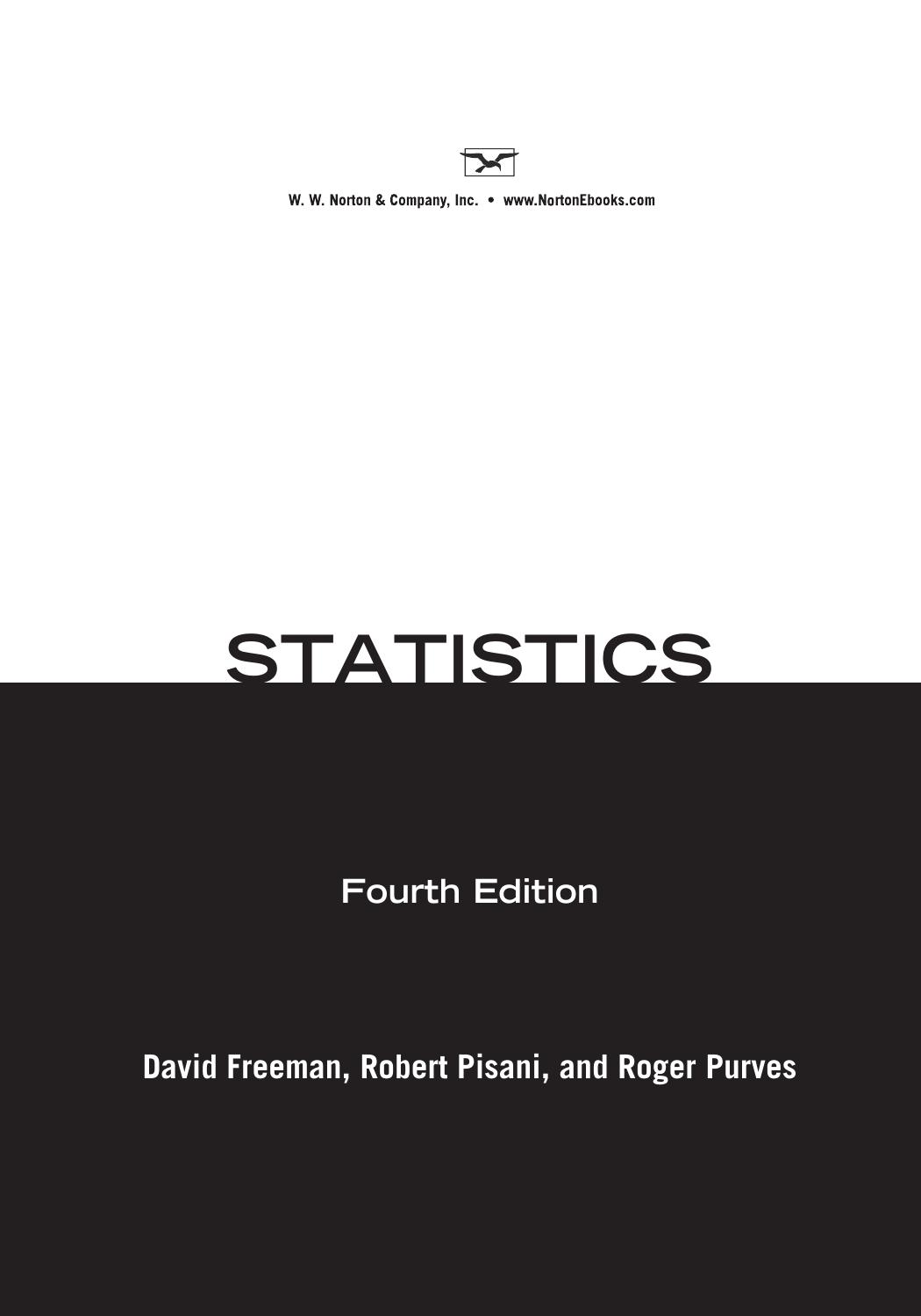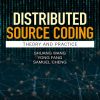Statistics 4th Edition by David Freedman, Robert Pisani, Roger Purves ISBN 0393522105 9780393522105
$70.00 Original price was: $70.00.$35.00Current price is: $35.00.
Instant download Statistics 4th Edition By David Freedman Robert Pisani Fei Sao Miao David Freeman Robert Pisani & Roger Purves after payment
Statistics 4th Edition by David Freedman, Robert Pisani, Roger Purves – Ebook PDF Instant Download/Delivery: 0393522105, 9780393522105
Full download Statistics 4th Edition after payment

Product details:
ISBN 10: 0393522105
ISBN 13: 9780393522105
Author: David Freedman, Robert Pisani, Roger Purves
Renowned for its clear prose and no-nonsense emphasis on core concepts, Statistics covers fundamentals using real examples to illustrate the techniques. The Fourth Edition has been carefully revised and updated to reflect current data.
Statistics 4th Table of contents:
Part I: Design of Experiments
1: Controlled Experiments
1. The Salk Vaccine Field Trial
2. The Portacaval Shunt
3. Historical Controls
4. Summary
2: Observational Studies
1. Introduction
2. The Clofibrate Trial
3. More Examples
4. Sex Bias in Graduate Admissions
5. Confounding
6. Review Exercises
7. Summary and Overview
Part II: Descriptive Statistics
3: The Histogram
1. Introduction
2. Drawing a Histogram
3. The Density Scale
4. Variables
5. Controlling for a Variable
6. Cross-Tabulation
7. Selective Breeding
8. Review Exercises
9. Summary
4: The Average and the Standard Deviation
1. Introduction
2. The Average
3. The Average and the Histogram
4. The Root-Mean-Square
5. The Standard Deviation
6. Computing the Standard Deviation
7. Using a Statistical Calculator
8. Review Exercises
9. Summary
5: The Normal Approximation for Data
1. The Normal Curve
Finding Areas Under the Normal Curve
3. The Normal Approximation for Data
4. Percentiles
5. Percentiles and the Normal Curve
6. Change of Scale
7. Review Exercises
8. Summary
6: Measurement Error
1. Introduction
2. Chance Error
3. Outliers
4. Bias
5. Review Exercises
6. Special Review Exercises
7. Summary and Overview
7: Plotting Points and Lines
1. Reading Points Off a Graph
2. Plotting Points
3. Slope and Intercept
4. Plotting Lines
5. The Algebraic Equation for a Line
Part III: Correlation and Regression
8: Correlation
1. The Scatter Diagram
2. The Correlation Coefficient
3. The SD Line
4. Computing the Correlation Coefficient
5. Review Exercises
6. Summary
9: More about Correlation
1. Features of the Correlation Coefficient
2. Changing SDs
3. Some Exceptional Cases
4. Ecological Correlations
5. Association is Not Causation
6. Review Exercises
7. Summary
10: Regression
1. Introduction
2. The Graph of Averages
3. The Regression Method for Individuals
4. The Regression Fallacy
5. There are Two Regression Lines
6. Review Exercises
7. Summary
11: The R.M.S. Error for Regression
1. Introduction
2. Computing the R.M.S. Error
3. Plotting the Residuals
4. Looking at Vertical Strips
5. Using the Normative Curve Inside a Vertical Strip
6. Review Exercises
7. Summary
12: The Regression Line
1. Slope and Intercept
2. The Method of Least Squares
3. Does the Regression Make Sense?
4. Review Exercises
5. Summary and Overview
Part IV: Probability
13: What are the Chances?
1. Introduction
2. Conditional Probabilities
3. The Multiplication Rule
4. Independence
5. The Collins Case
6. Review Exercises
7. Summary
14: More about Chance
1. Listing the Ways
2. The Addition Rule
3. Two FAQs (Frequently Asked Questions)
4. The Paradox of Chevalier de Méré
5. Are Real Dice Fair?
6. Review Exercises
7. Summary
15: The Binomial Formula
1. Introduction
2. The Binomial Formula
3. Review Exercises
4. Special Review Exercises
5. Summary and Overview
Part V: Chance Variability
16: The Law of Averages
1. What Does the Law of Averages Say?
2. Chance Processes
3. The Sum of Draws
4. Making a Box Model
5. Review Exercises
6. Summary
17: The Expected Value and Standard Error
1. The Expected Value
2. The Standard Error
3. Using the Normal Curve
4. A Short-Cut
5. Classifying and Counting
6. Review Exercises
7. Postscript
8. Summary
18: The Normal Approximation for Probability Histograms
1. Introduction
2. Probability Histograms
3. Probability Histograms and the Normal Curve
4. The Normal Approximation
5. The Scope of the Normal Approximation
6. Conclusion
7. Review Exercises
8. Summary
Part VI: Sampling
19: Sample Surveys
1. Introduction
2. The Literary Digest Poll
3. The Year the Polls Elected Dewey
4. Using Chance in Survey Work
5. How Well Do Probability Methods Work?
6. A Closer Look at the Gallup Poll
7. Telephone Surveys
8. Chance Error and Bias
9. Review Exercises
10. Summary
20: Chance Errors in Sampling
1. Introduction
2. The Expected Value and Standard Error
3. Using the Normal Curve
4. The Correction Factor
5. The Gallup Poll
6. Review Exercises
7. Summary
21: The Accuracy of Percentages
1. Introduction
2. Confidence Intervals
3. Interpreting a Confidence Interval
4. Caveat Emptor
5. The Gallup Poll
6. Review Exercises
7. Summary
22: Measuring Employment and Unemployment
1. Introduction
2. The Design of the Current Population Survey
3. Carrying Out the Survey
4. Weighting the Sample
5. Standard Errors
6. The Quality of the Data
7. Bias
8. Review Exercises
9. Summary
23: The Accuracy of Averages
1. Introduction
2. The Sample Average
3. Which SE?
4. A Reminder
5. Review Exercises
6. Special Review Exercises
7. Summary and Overview
Part VII: Chance Models
24: A Model For Measurement Error
1. Estimating the Accuracy of an Average
2. Chance Models
3. The Gauss Model
4. Conclusion
5. Review Exercises
6. Summary
25: Chance Models in Genetics
1. How Mendel Discovered Genes
2. Did Mendel’s Facts Fit His Model?
3. The Law of Regression
4. An Appreciation of the Model
5. Review Exercises
6. Summary and Overview
Part VIII: Tests of Significance
26: Tests of Significance
1. Introduction
2. The Null and the Alternative
3. Test Statistics and Significance Levels
4. Making a Test of Significance
5. Zero-One Boxes
6. The t-Test
7. Review Exercises
8. Summary
27: More Tests for Averages
1. The Standard Error for a Difference
2. Comparing Two Sample Averages
3. Experiments
4. More on Experiments
5. When Does the z-Test Apply?
6. Review Exercises
7. Summary
28: The Chi-Square Test
1. Introduction
2. The Structure of the χ2-Test
3. How Fisher Used the χ2-Test
4. Testing Independence
5. Review Exercises
6. Summary
29: A Closer Look at Tests of Significance
1. Was the Result Significant?
2. Data Snooping
3. Was the Result Important?
4. The Role of the Model
5. Does the Difference Prove the Point?
6. Conclusion
7. Review Exercises
8. Special Review Exercises
9. Summary and Overview
People also search for Statistics 4th:
statistics
descriptive statistics
inferential statistics
vital statistics
phillies statistics


